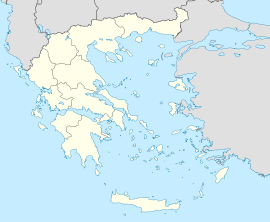- Dimini
-
For the village in southern Greece, see Dimini, Corinthia.
Dimini
ΔιμήνιLocation Coordinates 39°21′N 22°53′E / 39.35°N 22.883°ECoordinates: 39°21′N 22°53′E / 39.35°N 22.883°E Government Country: Greece Region: Thessaly Regional unit: Magnesia Municipality: Volos Municipal unit: Aisonia Population statistics (as of 2001) Community - Population: 2,125 Other Time zone: EET/EEST (UTC+2/3) Dimini (Greek: Διμήνι; older form: Diminion) is a village near the city of Volos, in Thessaly (central Greece), in Magnesia. It was the seat of the municipality of Aisonia. The name Aisonia dates back to ancient times and it is the westernmost place in the Volos area. The Dimini area contains both a Mycenean settlement and a Neolithic settlement. The Neolithic settlement in Dimini was discovered near the end of 19th century and was first excavated by Greek archaeologists Christos Tsountas and Valerios Stais.
The palace of ancient Iolcos is believed to be located in modern-day Dimini, where a Mycenaean palace was excavated recently [1].
Contents
Information
In 1886, Lolling and Wolters excavated the Mycenean tholos tomb known as Lamiospito. In 1901, Valerios Stais discovered the tholos tomb on the hill of the Neolithic settlement. He worked at the Dimini settlement with Christos Tsountas from 1901 up until 1903. In 1977, George Chourmouziadis continued excavations at the Neolithic settlement. Excavations of the Mycenean settlement in Dimini began in 1980 by V. Adrimi-Sismani. In 2001 the excavations uncovered a Mycenaean city and palace complex they believe could be part of ancient Iolkos. A stone weight and a sherd inscribed with Linear B writing were also uncovered. The publication of the results can be found here.
The "invasion theory" states that the people of the Neolithic Dimini culture were responsible for the violent conquest of the Sesklo culture at around 5000 BC. Moreover, the theory considers the "Diminians" and the "Seskloans" as two separate cultural entities. However, I. Lyritzis provides a different story pertaining to the relations between the Dimini and the Sesklo cultures. He, along with R. Galloway, compared ceramic materials from both Sesklo and Dimini utilizing thermoluminescence dating methods. He discovered that the inhabitants of the settlement in Dimini appeared around 4800 BC, four centuries before the fall of the Sesklo civilization (ca. 4400 BC). Lyritzis concluded that the "Seskloans" and "Diminians" coexisted for a period of time.
Holocene Epoch
↑ Pleistocene Holocene/Anthropocene - Preboreal (10.3 ka – 9 ka),
- Boreal (9 ka – 7.5 ka),
- Atlantic (7.5 ka – 5 ka),
- Subboreal (5 ka – 2.5 ka)
- Subatlantic (2.5 ka – present)
Other
Dimini has a school, a lyceum, a post office, banks and a square (plateia).
Notes
Source
See also
External links
- Hellenic Ministry of Culture: Dimini
- Metis: Dimini
- Photos of the Dimini settlement, Magnesia (in Greek)
North: Nea Ionia/Iolkos West: Feres Aisonia East: Pagasetic Gulf South: Nea Agchialos Municipal unit of Agria Agria · DrakeiaMunicipal unit of Aisonia Dimini · SeskloMunicipal unit of Artemida Municipal unit of Iolcos Agios Onoufrios · Anakasia · Ano VolosMunicipal unit of Makrinitsa Municipal unit of Nea Anchialos Municipal unit of Nea Ionia Glafyra · Nea IoniaMunicipal unit of Portaria Municipal unit of Volos Categories:- Populated places in Magnesia
- Populated places established in the 5th millennium BC
- Neolithic settlements in Thessaly
- Mycenaean archaeological sites in Thessaly
Wikimedia Foundation. 2010.

